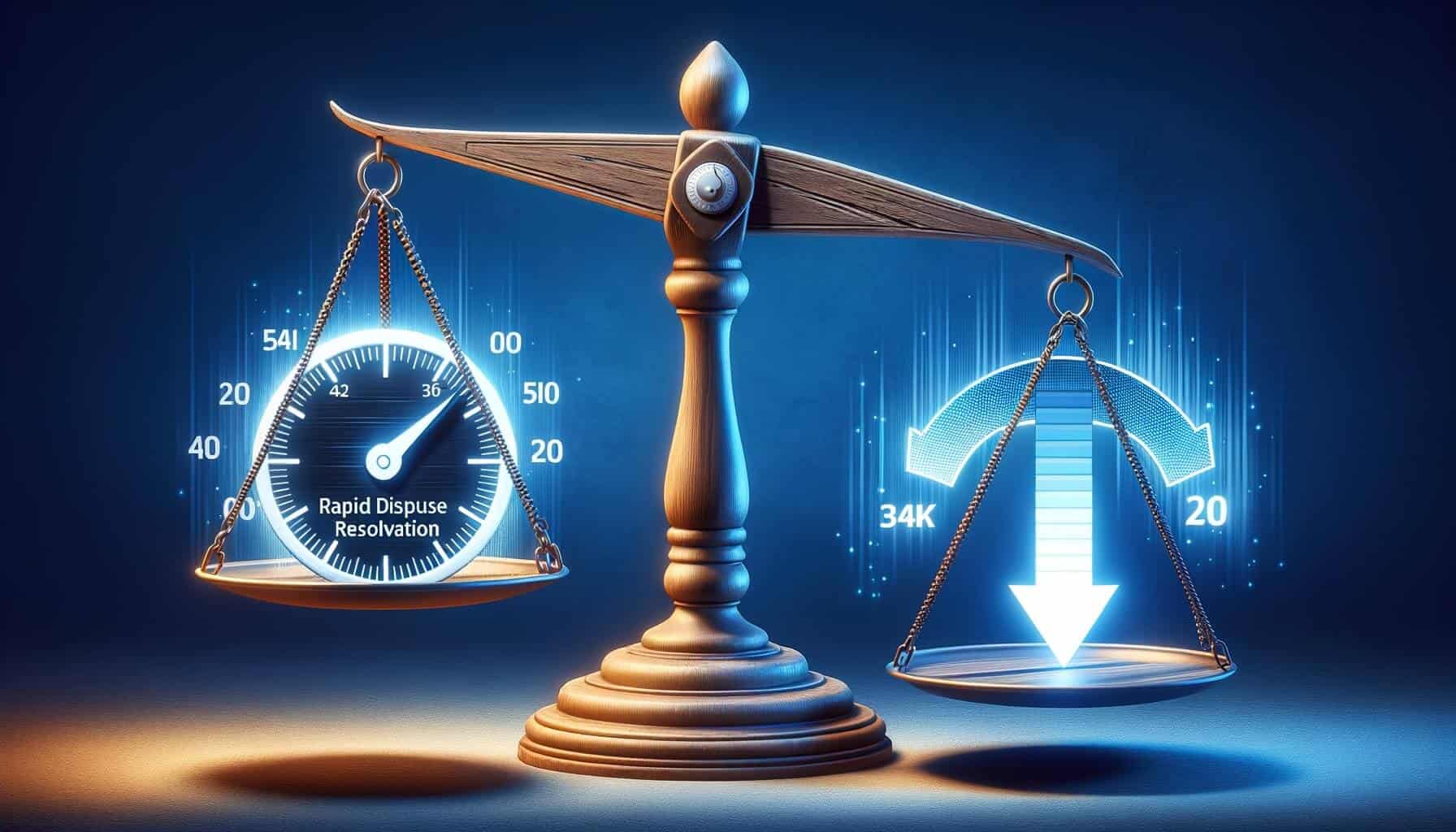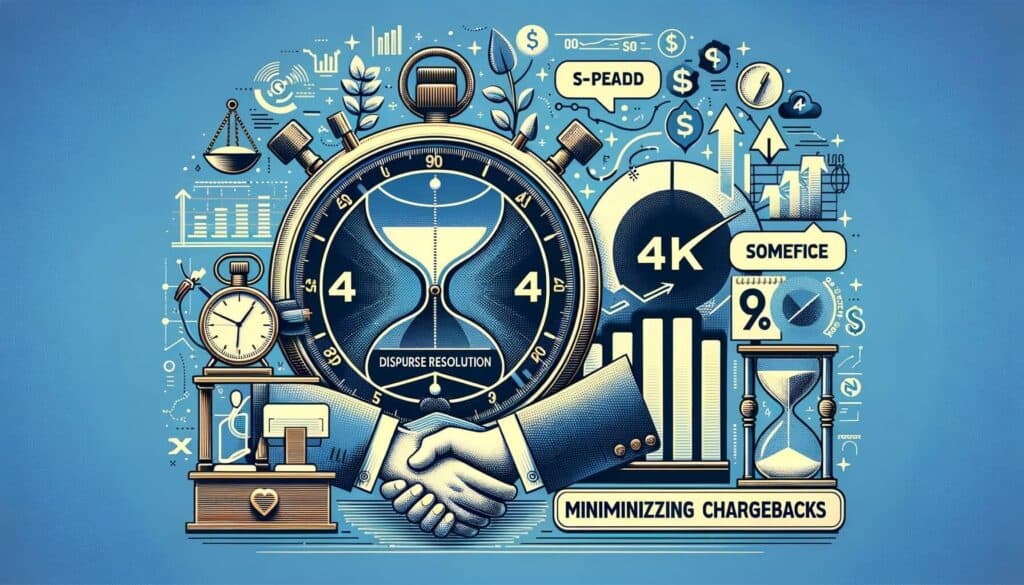
By Barbara Thomas April 23, 2025
In today’s digital age, chargebacks have become a common occurrence in the business world. A chargeback is a transaction reversal initiated by the cardholder’s bank, usually due to a dispute or fraudulent activity. While chargebacks are meant to protect consumers, they can have a significant impact on businesses, leading to financial losses, damaged reputation, and increased operational costs. Therefore, it is crucial for businesses to maintain a low chargeback rate to ensure their long-term success and profitability.
A low chargeback rate indicates that a business has successfully resolved customer disputes and minimized the number of chargebacks filed against them. This not only helps in preserving the business’s financial stability but also enhances customer trust and loyalty. In this article, we will explore how rapid dispute resolution can help businesses keep a low chargeback rate and the various strategies and technologies that can be employed to achieve this goal.
What is Rapid Dispute Resolution and How Does it Work?

Rapid dispute resolution refers to the process of quickly and efficiently resolving customer disputes and chargebacks. It involves a systematic approach that aims to address customer concerns, provide timely resolutions, and prevent chargebacks from escalating further. The key to rapid dispute resolution lies in effective communication, utilizing technology, and implementing proactive strategies.
When a customer initiates a dispute or files a chargeback, the business must respond promptly and gather all relevant information related to the transaction. This includes reviewing transaction records, customer communication, and any supporting evidence. Once the necessary information is collected, the business can then assess the validity of the dispute and take appropriate action to resolve it.
The Benefits of Rapid Dispute Resolution in Reducing Chargebacks

Implementing rapid dispute resolution in your business can yield numerous benefits in reducing chargebacks. Let’s explore some of the key advantages:
1. Minimizing financial losses: Chargebacks can result in significant financial losses for businesses, including the loss of the disputed amount, chargeback fees, and potential penalties. By resolving disputes rapidly, businesses can prevent these losses and maintain their financial stability.
2. Preserving customer trust and loyalty: When customers experience a problem with a purchase, they expect a quick and satisfactory resolution. By promptly addressing their concerns and resolving disputes, businesses can demonstrate their commitment to customer satisfaction, thereby preserving trust and loyalty.
3. Protecting reputation: High chargeback rates can damage a business’s reputation, leading to negative reviews, decreased customer confidence, and potential loss of future sales. Rapid dispute resolution helps in mitigating these risks by resolving issues before they escalate and maintaining a positive brand image.
4. Streamlining operations: By implementing efficient dispute resolution processes, businesses can streamline their operations and reduce the time and resources spent on managing chargebacks. This allows them to focus on core business activities and improve overall efficiency.
Strategies for Implementing Rapid Dispute Resolution in Your Business

To effectively implement rapid dispute resolution in your business, consider the following strategies:
1. Establish clear dispute resolution policies: Develop clear and concise policies that outline the steps to be followed when a dispute arises. These policies should include guidelines for gathering information, assessing the validity of disputes, and determining appropriate resolutions.
2. Train your staff: Provide comprehensive training to your staff on dispute resolution procedures, customer service skills, and effective communication techniques. This will empower them to handle disputes efficiently and provide satisfactory resolutions to customers.
3. Offer multiple channels for dispute resolution: Provide customers with various channels to raise their concerns and disputes, such as phone, email, or live chat. This ensures that customers can choose the most convenient method to reach out and facilitates faster resolution.
4. Implement proactive monitoring: Regularly monitor transactions and customer feedback to identify potential disputes before they escalate into chargebacks. This allows businesses to address issues promptly and prevent chargebacks from occurring in the first place.
5. Collaborate with payment processors and banks: Establish strong relationships with your payment processors and banks to gain access to their dispute resolution tools and resources. This collaboration can help expedite the resolution process and reduce the likelihood of chargebacks.
The Role of Effective Communication in Rapid Dispute Resolution

Effective communication plays a crucial role in rapid dispute resolution. It is essential to establish clear lines of communication with customers and ensure that their concerns are heard and addressed promptly. Here are some key aspects of effective communication in dispute resolution:
1. Prompt response: Respond to customer disputes and chargebacks as soon as possible. Acknowledge their concerns and provide a timeline for resolution. This demonstrates your commitment to resolving the issue promptly.
2. Active listening: Listen attentively to customers’ concerns and ask clarifying questions to fully understand the issue. This shows empathy and helps in identifying the root cause of the problem.
3. Clear and concise communication: Use clear and concise language when communicating with customers. Avoid technical jargon and provide step-by-step instructions to guide them through the resolution process.
4. Transparency: Be transparent with customers about the progress of their dispute resolution. Keep them informed about any updates, actions taken, and expected timelines. This builds trust and reassures customers that their concerns are being addressed.
5. Professionalism and empathy: Maintain a professional and empathetic tone throughout the communication process. Show understanding and empathy towards customers’ frustrations and assure them that you are committed to finding a satisfactory resolution.
Utilizing Technology for Efficient and Timely Dispute Resolution
Technology plays a vital role in enabling efficient and timely dispute resolution. Here are some ways businesses can leverage technology to streamline their dispute resolution processes:
1. Automated dispute management systems: Implement automated dispute management systems that can track, manage, and prioritize customer disputes. These systems can help businesses stay organized, ensure timely responses, and reduce manual errors.
2. Real-time transaction monitoring: Utilize real-time transaction monitoring tools to identify potential disputes and fraudulent activities. These tools can alert businesses to suspicious transactions, allowing them to take immediate action and prevent chargebacks.
3. Customer self-service portals: Provide customers with self-service portals where they can easily initiate and track their disputes. These portals enable customers to submit relevant information, upload supporting documents, and monitor the progress of their dispute resolution.
4. Data analytics and reporting: Utilize data analytics tools to analyze dispute patterns, identify common issues, and implement preventive measures. Reporting features can provide insights into dispute resolution performance, allowing businesses to identify areas for improvement.
5. Integration with payment processors: Integrate your dispute resolution systems with payment processors to streamline the communication and information exchange process. This integration enables faster resolution by eliminating manual data entry and ensuring accurate and up-to-date information.
How to Choose the Right Rapid Dispute Resolution Provider for Your Business
Choosing the right rapid dispute resolution provider is crucial for the success of your business. Here are some factors to consider when selecting a provider:
1. Expertise and experience: Look for a provider with extensive experience in dispute resolution and a deep understanding of your industry. They should have a proven track record of successfully resolving disputes and reducing chargebacks.
2. Technology capabilities: Assess the provider’s technology capabilities and ensure that their systems are robust, secure, and user-friendly. The provider should offer features such as automated dispute management, real-time monitoring, and customer self-service portals.
3. Integration capabilities: Consider the provider’s ability to integrate with your existing systems, such as payment processors and customer relationship management (CRM) software. Seamless integration ensures smooth data flow and reduces manual effort.
4. Customer support: Evaluate the provider’s customer support capabilities, including their availability, responsiveness, and expertise. Prompt and knowledgeable support is essential for resolving any technical issues or concerns that may arise during the dispute resolution process.
5. Cost-effectiveness: Compare the pricing models of different providers and assess the value they offer. Consider factors such as transaction volume, additional features, and any hidden costs. Choose a provider that offers a cost-effective solution without compromising on quality.
Common FAQs about Rapid Dispute Resolution and Chargebacks
Q1. What is the difference between a dispute and a chargeback?
Answer: A dispute is a customer’s disagreement with a transaction, while a chargeback is a formal request made by the cardholder’s bank to reverse the transaction. Disputes can be resolved directly between the customer and the business, while chargebacks involve the bank’s intervention.
Q2. How can rapid dispute resolution help in reducing chargebacks?
Answer: Rapid dispute resolution ensures that customer concerns are addressed promptly, preventing them from escalating into chargebacks. By resolving disputes quickly and efficiently, businesses can minimize financial losses, preserve customer trust, and protect their reputation.
Q3. Can rapid dispute resolution prevent all chargebacks?
Answer: While rapid dispute resolution can significantly reduce chargebacks, it cannot prevent them entirely. Some chargebacks may occur due to fraudulent activities or situations beyond the business’s control. However, by implementing effective dispute resolution strategies, businesses can minimize the number of chargebacks filed against them.
Q4. What role does effective communication play in dispute resolution?
Answer: Effective communication is essential in dispute resolution as it helps in understanding customer concerns, providing timely updates, and building trust. Clear and empathetic communication ensures that customers feel heard and valued, increasing the chances of a satisfactory resolution.
Q5. How can technology facilitate efficient dispute resolution?
Answer: Technology enables businesses to automate dispute management, monitor transactions in real-time, and provide self-service portals for customers. These tools streamline the dispute resolution process, reduce manual effort, and ensure timely responses.
Conclusion
Maintaining a low chargeback rate is crucial for businesses to thrive in today’s competitive landscape. Rapid dispute resolution plays a vital role in achieving this goal by addressing customer concerns promptly, minimizing financial losses, and preserving customer trust and loyalty.
By implementing effective communication strategies, leveraging technology, and choosing the right dispute resolution provider, businesses can streamline their operations, reduce chargebacks, and ensure long-term success. Embracing rapid dispute resolution as a core business practice will not only protect businesses from financial losses but also enhance their reputation and customer satisfaction.